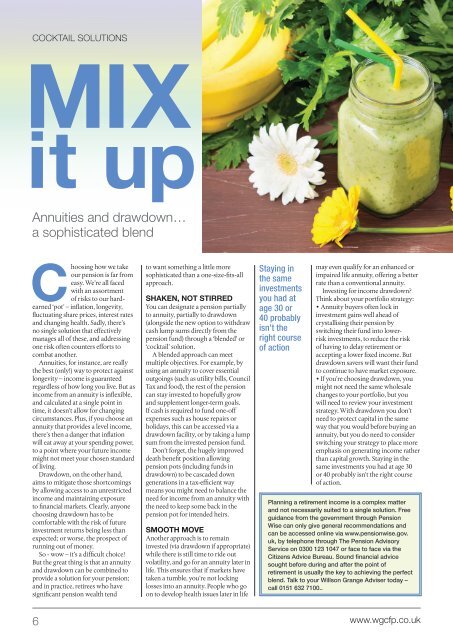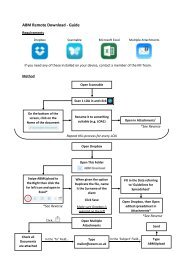Create successful ePaper yourself
Turn your PDF publications into a flip-book with our unique Google optimized e-Paper software.
COCKTAIL SOLUTIONS<br />
MIX<br />
it up<br />
Annuities and drawdown…<br />
a sophisticated blend<br />
Choosing how we take<br />
our pension is far from<br />
easy. We’re all faced<br />
with an assortment<br />
of risks to our hardearned<br />
‘pot’ – inflation, longevity,<br />
fluctuating share prices, interest rates<br />
and changing health. Sadly, there’s<br />
no single solution that effectively<br />
manages all of these, and addressing<br />
one risk often counters efforts to<br />
combat another.<br />
Annuities, for instance, are really<br />
the best (only!) way to protect against<br />
longevity – income is guaranteed<br />
regardless of how long you live. But as<br />
income from an annuity is inflexible,<br />
and calculated at a single point in<br />
time, it doesn’t allow for changing<br />
circumstances. Plus, if you choose an<br />
annuity that provides a level income,<br />
there’s then a danger that inflation<br />
will eat away at your spending power,<br />
to a point where your future income<br />
might not meet your chosen standard<br />
of living.<br />
Drawdown, on the other hand,<br />
aims to mitigate those shortcomings<br />
by allowing access to an unrestricted<br />
income and maintaining exposure<br />
to financial markets. Clearly, anyone<br />
choosing drawdown has to be<br />
comfortable with the risk of future<br />
investment returns being less than<br />
expected; or worse, the prospect of<br />
running out of money.<br />
So - wow – it’s a difficult choice!<br />
But the great thing is that an annuity<br />
and drawdown can be combined to<br />
provide a solution for your pension;<br />
and in practice, retirees who have<br />
significant pension wealth tend<br />
to want something a little more<br />
sophisticated than a one-size-fits-all<br />
approach.<br />
SHAKEN, NOT STIRRED<br />
You can designate a pension partially<br />
to annuity, partially to drawdown<br />
(alongside the new option to withdraw<br />
cash lump sums directly from the<br />
pension fund) through a ‘blended’ or<br />
‘cocktail’ solution.<br />
A blended approach can meet<br />
multiple objectives. For example, by<br />
using an annuity to cover essential<br />
outgoings (such as utility bills, Council<br />
Tax and food), the rest of the pension<br />
can stay invested to hopefully grow<br />
and supplement longer-term goals.<br />
If cash is required to fund one-off<br />
expenses such as house repairs or<br />
holidays, this can be accessed via a<br />
drawdown facility, or by taking a lump<br />
sum from the invested pension fund.<br />
Don’t forget, the hugely improved<br />
death benefit position allowing<br />
pension pots (including funds in<br />
drawdown) to be cascaded down<br />
generations in a tax-efficient way<br />
means you might need to balance the<br />
need for income from an annuity with<br />
the need to keep some back in the<br />
pension pot for intended heirs.<br />
SMOOTH MOVE<br />
Another approach is to remain<br />
invested (via drawdown if appropriate)<br />
while there is still time to ride out<br />
volatility, and go for an annuity later in<br />
life. This ensures that if markets have<br />
taken a tumble, you’re not locking<br />
losses into an annuity. People who go<br />
on to develop health issues later in life<br />
Staying in<br />
the same<br />
investments<br />
you had at<br />
age 30 or<br />
40 probably<br />
isn’t the<br />
right course<br />
of action<br />
may even qualify for an enhanced or<br />
impaired life annuity, offering a better<br />
rate than a conventional annuity.<br />
Investing for income drawdown?<br />
Think about your portfolio strategy:<br />
<br />
investment gains well ahead of<br />
crystallising their pension by<br />
switching their fund into lowerrisk<br />
investments, to reduce the risk<br />
of having to delay retirement or<br />
accepting a lower fixed income. But<br />
drawdown savers will want their fund<br />
to continue to have market exposure.<br />
<br />
might not need the same wholesale<br />
changes to your portfolio, but you<br />
will need to review your investment<br />
strategy. With drawdown you don’t<br />
need to protect capital in the same<br />
way that you would before buying an<br />
annuity, but you do need to consider<br />
switching your strategy to place more<br />
emphasis on generating income rather<br />
than capital growth. Staying in the<br />
same investments you had at age 30<br />
or 40 probably isn’t the right course<br />
of action.<br />
!"#$$%$&'#'()*%()+)$*'%$,-+)'%.'#',-+/")0'+#**)('<br />
#$1'$-*'$),)..#(%"2'.3%*)1'*-'#'.%$&")'.-"3*%-$4'5())'<br />
&3%1#$,)'6(-+'*7)'&-8)($+)$*'*7(-3&7'!)$.%-$'<br />
9%.)',#$'-$"2'&%8)'&)$)(#"'(),-++)$1#*%-$.'#$1'<br />
,#$':)'#,,)..)1'-$"%$)'8%#';;;4/)$.%-$;%.)4&-84<br />
3



